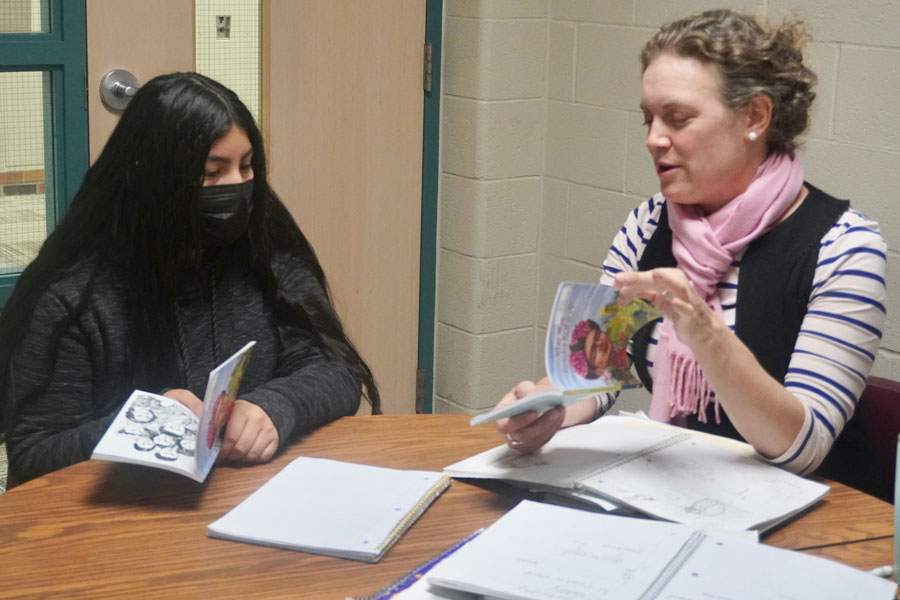Clay, a multilingual learner teacher in her 11th year of teaching at Mill Creek Middle School in the English Language Learner program, said making visuals helps ELL learners with recall and retention of new information. She said research has shown that drawing more than writing has proven to be more effective as a memory aid.
To help her ELL students understand the difference between characters in what they read, Clay has them draw the characters and make notations in a dedicated notebook. Clay keeps a collection of them that are a cross between graphic novels and CliffsNotes with doodles.
Eighth-grader Araceli Torres-Perez said drawing in notebooks helps her comprehend classwork and literature as she learns English. She moved to Comstock Park from Mexico about 15 months ago.
“I can draw the actions of the characters and then remember the drawing and know what part of the story it is,” Araceli said in Spanish as Clay translated for a visitor.
Clay said Araceli was a straight-A student in Mexico who was reading at the 12th-grade level, and is highly motivated to improve her English. In a recent session, Clay asked Araceli what she thought of the book “Who Was Frida Kahlo?” that her class was reading.
“Look at this page right now. Do you see any of the prepositions we’ve been talking about?” Araceli pointed out the preposition “into.” To help her understand the word “throughout” Clay drew an arrow to illustrate going through it.
Araceli explained how the notebooks help: “Many times, I only understand some works or I confuse others, so I don’t understand what the story is telling.” She writes the meaning of English words that are difficult for her in Spanish, then makes drawings about the actions of the characters or the setting to better understand the story and the meanings of words.
Amy Clay has spent the past few summers traveling in Ecuador (pictured), Cuba and Mexico
Doodling to Improved Test Scores
The effectiveness of Clay’s methods may be seen in test scores. From fall 2021 to spring 2022, reading MAP (Measures of Academic Progress) scores in her newcomers class improved by an average of 11.6 points. Her reading class with ELL and non-ELL students considered high risk improved by an average of 6.7 points, as did the reading MAP scores for the general ELL population.
Clay said she has great memory and often makes visual archives in her head.
“Visuals can help me focus and make a memory picture in my head in a way that text cannot,” she said.
She noted the book “The Doodle Revolution” discusses the process of summarizing information via drawings. Doodles help anchor the thinking of the student making the drawing.
“They have to edit and focus on the most important parts,” Clay said. “It helps them keep track of all the information. The quality of the drawing is not as important as the process of the learner making the drawing.”
She said she has found that visual learning is especially important for students who do not speak English or Spanish.
“Finding and producing my own non-linguistic examples of the literature they were studying and concepts they needed for school was key.” She reads and learns large works of literature and other things at the same time as the students, and said her use of notebooks soared when she had students from Iraq and Africa.
 https://snn-images.schoolnewsnetwork.org/wp-content/uploads/2022/11/29153359/CP-English-Language-Learner-visual-methods1-300x200.jpg 300w, https://snn-images.schoolnewsnetwork.org/wp-content/uploads/2022/11... 150w, https://snn-images.schoolnewsnetwork.org/wp-content/uploads/2022/11... 768w, https://snn-images.schoolnewsnetwork.org/wp-content/uploads/2022/11... 696w" data-lazy-loaded="1" sizes="(max-width: 900px) 100vw, 900px" loading="eager" />
https://snn-images.schoolnewsnetwork.org/wp-content/uploads/2022/11/29153359/CP-English-Language-Learner-visual-methods1-300x200.jpg 300w, https://snn-images.schoolnewsnetwork.org/wp-content/uploads/2022/11... 150w, https://snn-images.schoolnewsnetwork.org/wp-content/uploads/2022/11... 768w, https://snn-images.schoolnewsnetwork.org/wp-content/uploads/2022/11... 696w" data-lazy-loaded="1" sizes="(max-width: 900px) 100vw, 900px" loading="eager" />Amy Clay works with eighth-grader Araceli Torres-Perez to help her understand the literature her class is reading
Developing Empathy, Patience
Clay is one of four ELL teachers in the district . They oversee 199 students who represent 14 different languages.
Her work, education and travel experiences make her uniquely qualified to work with ELL students. She earned a social science degree from the University of Michigan and spent two years at Hampshire College in Massachusetts, where studies must be linked to a third-world perspective. She earned post-graduate teaching credentials at Mills College in Oakland, California with a focus on equity and ELL, and a master’s degree from Boston University, where her thesis focused on multicultural consideration in curriculum planning for the art classroom. She’s taken additional courses covering memory recall, reading and the brain, and visual culture.
Clay spent many summers living amid other cultures including in Yemen, London, rural Scotland and Italy. She worked in documentary production in the Midwest and California and taught university-level English as a foreign language in Ecuador. She also worked for five years as a resident adviser at a Japanese university in Boston.
Drawings and notations in one of Amy Clay’s notebooks aid ELL students with their comprehension of literature
For the past three years she has spent summers volunteering and studying language, history and culture in Ecuador, Cuba and Mexico.
“I’d say the two most influential cross-cultural experiences in helping me work with the ELL students and families of Comstock Park are living with Japanese students for five years and living and teaching in Ecuador for a year,” Clay said.
“It helped me learn the confusion and misunderstandings that can occur when you feel like the outsider linguistically and culturally, and when people think of you as ‘the other.’
“It is a constant challenge to be understood in a language that is not your native language. Living in another culture and language can be super humbling, and helps develop empathy and patience with those who take that risk.”





You need to be a member of THE VISUAL TEACHING NETWORK to add comments!
Join THE VISUAL TEACHING NETWORK